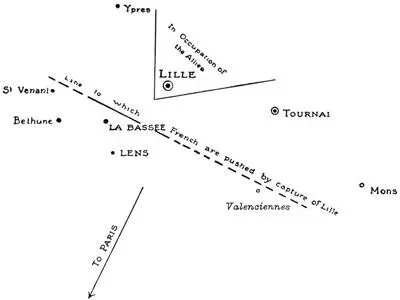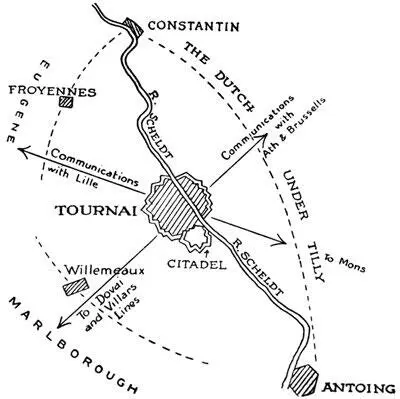Such is the general political setting of this fierce action, one of the most determined known in the history of European arms, and therefore one of the most legitimately glorious; one in which men were most ready at the call of duty and under the influences of discipline to sacrifice their lives in the defence of a common cause; and one which, as all such sacrifices must, illumines the history of the several national traditions concerned, of the English as of the Dutch, of the German principalities as of the French.
No action better proves the historical worth of valour.
Table of Contents
When the negotiations for peace had failed, that is, with the opening of June 1709, the King of France and his forces had particularly to dread an invasion of the country and the march on Paris.
The accompanying sketch map will show under what preoccupations the French commander upon the north-eastern frontier lay.
Lille was in the hands of the enemy. There was still a small French garrison in Ypres, another in Tournai, and a third in Mons. These of themselves (considering that Lille, the great town, was now occupied by the allies, and considering also the width of the gap between Ypres and Tournai) could not prevent the invasion and the advance on the capital.
It was necessary to oppose some more formidable barrier to the line of advance which topography marked out for the allies into the heart of France.

Sketch Map showing how the Allies holding Lille thrust the French back
on to the defensive line St. Venant-Valenciennes, and thus cut off the
French garrisons of Ypres, Tournai, and Mons.
Some fear was indeed expressed lest a descent should be made on the coasts and an advance attempted along the valley of the Somme. The fear was groundless. To organise the transportation of troops thus by sea, to disembark them, to bring and continue the enormous supply of provisions and ammunition they would require, was far less practical than to use the great forces already drawn up under Marlborough and Eugene in the Low Countries. Of what size these forces were we shall see in a moment.
The barrier, then, which Villars at the head of the French forces proceeded to erect, and which is known in history as “The Lines of La Bassée,” are the first point upon which we must fix our attention in order to understand the campaign of Malplaquet, and why that battle took place where it did.
It was upon the 3rd of June that Louis XIV. had written to Villars telling him that a renewal of the war would now be undertaken. On the 14th, Villars began to throw up earth for the formation of an entrenched camp between the marshy ground of Hulluch and that of Cuinchy. Here he proposed to concentrate the mass of his forces, with La Bassée just before him, the town of Lens behind. He used the waterways and the swamped ground in front and to the right for the formation of his defensive lines. These followed the upper valley of the Deule, the line of its canal, and finally reposed their right upon the river Scarpe. Though the regularly fortified line went no further than the camp near La Bassée, he also threw up a couple of entrenchments in front of Bethune and St. Venant in order to cover any march he might have to make towards his left should the enemy attempt to turn him in that direction.
It must further be noted that from the Scarpe eastward went the old “lines of La Trouille” thrown up in a former campaign, and now largely useless, but still covering, after a fashion, the neighbourhood of Mons.
Toward the end of the month of June Villars awaited the advance of the allies. His forces were inferior by 40,000 to those of his enemy. He had but eight men to their twelve. The season of the year, immediately preceding the harvest, made the victualling of his troops exceedingly difficult, nor was it until the day before the final assault was expected that the moneys necessary to their pay, and to the other purposes of the army, reached him; but he had done what he could, and, acting upon a national tradition which is as old as Rome, he had very wisely depended upon fortification.
The same conditions of the season which produced something like famine in the French camp, though they did not press equally severely upon that of the allies, rendered difficult the provisioning of their vast army also.
It was the first intention of Marlborough and Eugene to attack the lines at once, to force them, and to destroy the command of Villars. But these lines had been carefully reconnoitred, notably by Cadogan, who, with a party of English officers, and under a disguise, had made himself acquainted with their strength. It was determined, therefore, at the last moment, partly also from the fears of the Dutch, to whom the possession of every fortress upon the frontier was of paramount importance, to make but a “feint” upon Villars’ lines and to direct the army upon Tournai as its true object. The feint took the form of Eugene’s marching towards the left or western extremity of the line, Marlborough towards the eastern or right extremity near Douai, and this general movement was effected on the night of the 26th and 27th of June. In the midst of its execution, the feint (which for the moment deceived Villars) was arrested.
The 27th was passed without a movement, Villars refusing to leave his entrenchments, and the commanders of the allies giving no hint of their next intention. But during that same day Tilly with the Dutch had appeared before Tournai. On the evening of the day Marlborough himself was before the town. On the 28th Prince Eugene joined both the Dutch and Marlborough before the town, taking up his headquarters at Froyennes, Marlborough being at Willemeau, and the Dutch, under Tilly, already established on the east of Tournai from Antoing to Constantin, just opposite Eugene, where they threw a bridge across the Scheldt. By the evening of the 28th, therefore, Tournai was invested on every side, and the great allied armies of between 110,000 and 120,000 men had abandoned all hope of carrying Villars’ lines, and had sat down to the capture of the frontier fortress. 2
A comprehension of this siege of Tournai, which so largely determined the fortunes of the campaign of Malplaquet, will be aided by the accompanying sketch map. Here it is apparent that Marlborough with his headquarters at Willemeau, Eugene with his at Froyennes, the Dutch under Tilly in a semicircle from Antoing to Constantin, completed the investment of the fortress, and that the existing bridge at Antoing which the Dutch commanded, the bridge at Constantin which they had constructed, giving access over the river to the north and to the south, made the circle complete.

Sketch Map showing complete investment of Tournai.
The fortifications of Tournai were excellent. Vauban had superintended that piece of engineering in person, and the scheme of the fortifications was remarkable from the strength of the citadel which lay apart from the town (though within its ring of earthworks) to the south. The traveller can still recognise in its abandonment this enormous achievement of Louis XIV.’s sappers, and the opposition it was about to offer to the great hosts of Marlborough and Eugene does almost as much honour to the genius of the French engineer as to the tenacity of the little garrison then defending it.
Two factors in the situation must first be appreciated by the reader.
Читать дальше














